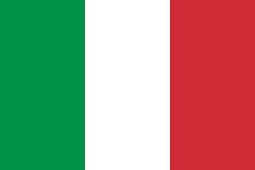
Back የጣልያ ሰንደቅ ዓላማ Amharic Bandera d'Italia AN علم إيطاليا Arabic علم ايطاليا ARZ Bandera d'Italia AST İtaliya bayrağı Azerbaijani ایتالیا بایراغی AZB Kobér Italia BAN Italėjės vieleva BAT-SMG Сцяг Італіі Byelorussian
 | |
| il Tricolore | |
| Use | National flag |
|---|---|
| Proportion | 2:3 |
| Adopted | 18 June 1946 (founding of the Italian Republic) |
| Design | A vertical tricolour of green, white and red |
 | |
| Use | Civil ensign |
| Proportion | 2:3 |
| Adopted | 9 November 1948 |
| Design | An Italian tricolour defaced with a variant of the arms of the Italian Navy and without a mural crown |
 | |
| Use | State ensign |
| Proportion | 2:3 |
| Adopted | 24 October 2003 |
| Design | An Italian tricolour defaced with the Emblem of Italy |
 | |
| Use | Naval ensign |
| Proportion | 2:3 |
| Adopted | 9 November 1947 |
| Design | An Italian tricolour defaced with the arms of the Italian Navy |
 | |
| Use | War flag |
| Proportion | 1:1 |
| Design | An Italian tricolour with a dimension ratio of 1:1 |
The flag of Italy (Italian: bandiera d'Italia, Italian: [banˈdjɛːra diˈtaːlja]), often referred to as The Tricolour (il Tricolore, Italian: [il trikoˈloːre]), is a flag featuring three equally sized vertical pales of green, white and red, with the green at the hoist side, as defined by Article 12 of the Constitution of the Italian Republic.[1] The Italian law regulates its use and display, protecting its defense and providing for the crime of insulting it; it also prescribes its teaching in Italian schools together with other national symbols of Italy.
The Italian Flag Day named Tricolour Day was established by law n. 671 of 31 December 1996, and is held every year on 7 January. This celebration commemorates the first official adoption of the tricolour as a national flag by a sovereign Italian state, the Cispadane Republic, a Napoleonic sister republic of Revolutionary France, which took place in Reggio Emilia on 7 January 1797, on the basis of the events following the French Revolution (1789–1799) which, among its ideals, advocated national self-determination. The Italian national colours appeared for the first time in Genoa on a tricolour cockade on 21 August 1789, anticipating by seven years the first green, white and red Italian military war flag, which was adopted by the Lombard Legion in Milan on 11 October 1796.
After 7 January 1797, popular support for the Italian flag grew steadily, until it became one of the most important symbols of Italian unification, which culminated on 17 March 1861 with the proclamation of the Kingdom of Italy, of which the tricolour became the national flag. Following its adoption, the tricolour became one of the most recognisable and defining features of united Italian statehood in the following two centuries of the history of Italy.
- ^ Costituzione della Repubblica Italiana Art. 12, 22 dicembre 1947, pubblicata nella Gazzetta Ufficiale n. 298 del 27 dicembre 1947 edizione straordinaria (published in the Official Gazette [of the Italian Republic] No. 298 of 27 December 1947 extraordinary edition) "La bandiera della Repubblica è il tricolore italiano: verde, bianco, e rosso, a tre bande verticali di eguali dimensioni"